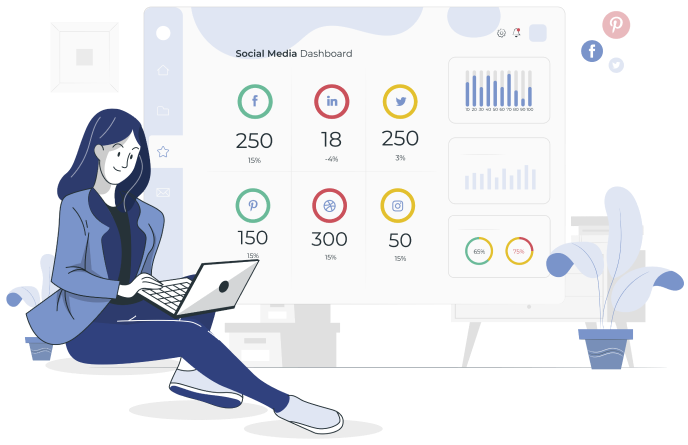Advertisement delivered through digital platforms, including social media, email, search engines, mobile apps, affiliate programs, and websites, is called digital advertising or Online Advertising. One of the main benefits of digital advertising is that advertisers are able to track the success of their campaigns in real-time. Advertising organically where consumers are and customizing ads to the target audience’s preferences is the goal of digital advertising.
Currently, digital advertising goes beyond basic targeting and banner ads. Prospect types, intent, stage of the sales funnel, and engagement patterns can now be targeted based on specific demographics, intent, and engagement patterns. We can apply these insights across display, search engine marketing (SEM), and search engine optimization (SEO), as well as social media, native advertising, pay-per-click, affiliate marketing, and mobile marketing.
Today, digital advertising has created a world in which you can and should develop a comprehensive strategy to find and engage your next customer, then stay in touch with them until they’re ready to buy.
As long as you embrace a more sophisticated approach to digital advertising, the advantages will far outweigh the costs. Relevance leads to increased engagement, which helps attract and nurture prospects until they become customers.
What is the purpose of a digital advertising strategy?
Digital advertising strategies should consider what the company’s goals are, what the company’s resources are, and, of course, who your buyers are. By evaluating all of these points, companies will be able to determine, from a plethora of options, what is the best value for their plans. It is ideal for them to deploy multiple strategies, which means not allocating all resources to just one. For instance, focusing on social media advertising, paid search, and even utilizing influencer marketing.
Assess the advantages and disadvantages of each idea and cross-check with your company’s main objectives and the profile of your buyer personas. A business can make much more accurate decisions when this information is defined.
A digital advertising strategy comprises a series of activities performed on the various digital platforms in accordance with the company’s objectives and resources. Additionally, you need to constantly monitor and evaluate your choices, to ensure that they are producing the expected results.
What are the 4 best digital advertising examples?
What could be better than knowing how to use examples in your digital advertising planning?
In order to inspire you to find the best idea for your business, we have broken them down into 4 application examples. Check them out!
1. SEM
The increased use of Google (and other search engines such as Bing and Yahoo) for Internet queries is undoubtedly a sign of the digital transformation. There are about 75,000 searches per second on Google alone. It is the most popular survey page – the choice of 92.07% of users – so how can we ignore it?
Within the possibilities of advertising on search engines, the Search Engine Marketing strategy stands out in two different techniques: SEO (Search Engine Optimization) and paid advertising.
The goal of SEO is to generate organic traffic through a variety of techniques and strategies. As a result of link building, keyword definitions, and high-quality content that is relevant to readers, the page will rank among the top results of the search engines.
The plan is long-term in nature. Despite the low cost and excellent return, the plan is long-term in nature. In contrast, paid advertising involves paying only for users who click on ads, maximizing the use of the company’s resources. An “Ad” favicon appears on Google for this type of content.
2. Display Ads
To use the display as an advertisement, one must create images and text to attract the attention of the user. Banner displays and ad spaces within websites geared toward your target audience are the most common methods. As an example, a sports news portal could be a good place for displaying ads for one e-commerce of sports article.
It is the same concept as an advertisement in a newspaper or magazine. When it comes to impacting a very segmented audience, it may not be as effective. Visual ads, on the other hand, are an excellent way to capture the user’s attention and compel them to click on your message.
3. Social Media Ads
It is undeniable that social media is one of the most efficient channels to communicate with your audience. Facebook boasts 2.5 million active users, while YouTube, WhatsApp, and Instagram add a combined 4.5 million. These channels are watched nearly an hour a day on average, according to studies.
Promoting products and services on these platforms is crucial for those who want to strengthen their brand awareness and digital presence. There is a possibility of reaching many people organically or in a paid way; better still, it can be segmented. Despite its relatively low costs, social media is a great digital advertising channel as well.
4. Email marketing
Even though email is an older channel of the internet age, it is still popular. Until 2023, Statista forecasts that the use of this channel will grow between 2% and 3% per year. What is the main reason? Consumer preference.
You’ll be able to get closer to your customer with so many people connected through this channel. In addition, email marketing has a high return on investment. A typical email campaign returns $40 on every dollar invested. To achieve this return, you should consider four aspects: obtaining qualified subscribers, engaging your audience, keeping them on your email list, and finding automation tools to streamline the process.
When you provide high-quality content to your audience, you will get qualified subscribers organically. Here’s the main rule: don’t buy email lists from anyone. Since they didn’t allow you to talk to them, it’s likely that they don’t even care about what you do. Therefore, you should build your list from scratch, based on people who are interested in what you have to offer.
DIGITAL ADVERTISING: HOW TO USE IT?
In digital advertising, advertisers use data to design ads that drive traffic to websites, generate leads, establish credibility, establish brand awareness, connect with target audiences, and ultimately convert them into sales. It’s important to keep in mind the goals of the company, a multi-faceted approach, and the resources available when designing a campaign. Some examples of digital advertising include:
● Search Engine Marketing:
These appear in search results as a small “ad” icon; these are by far the most well-known digital ads. For these ads, the two most common forms of payment are cost per click (pay per click) and cost per mile (pay per impression).
● Display ads:
These are advertisements that are designed as banners, pop-ups, and videos. They appear on third-party websites.
● Ads on social media:
Ads that pop up as you scroll through a social media feed might be very familiar to you. These can help you reach your target audience pretty quickly.
● Native advertising:
Advertisements that don’t look like ads; they’ll say recommended for you and match the content you’ve already seen. When you click the native ad, you’ll be redirected to the advertiser’s website.
● Remarketing:
Cookie-based digital advertising follows users on the web and shows them ads based on recent site visits, products, and services
Being relevant to your target audience means knowing what digital advertising is. If your brand is unknown, it makes no sense to offer the best prices or products. It is good news that you have several options to promote your business accurately, depending on your audience and goals.
Do you have a digital marketing strategy in place? Reach out to our team for better assistance!





 +91 8714 60 30 48
+91 8714 60 30 48
 + 971 44 92 87 30
+ 971 44 92 87 30




